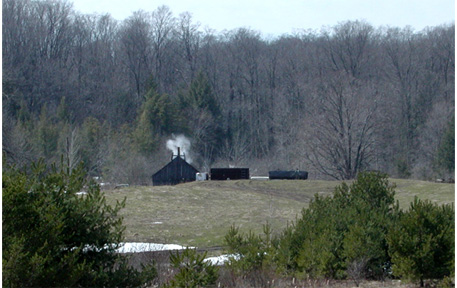
Maple Weekend in New York
In late March 2007, Elizabeth and Jim journeyed north (after carefully checking the weather forecast for late season snow) in the cruisemobile to view first-hand the process of making maple syrup. About 120 producers open doors in New York State for the two-weekend event.
We are not experts on the subject of making maple syrup, but we will attempt to explain the process as it was explained to us by these fine folks in New York who have been doing it for generations. Surprisingly, we learned that New York is the third largest maple-producing state behind Vermont and Maine. Canada is the world's leader in maple syrup production.
When looking for maple sugar shacks, it is easy to spot their plume of steam in distant fields. The steam comes from evaporation of water from the sap reduction process and not smoke from the fire.
Early shacks were placed convenient to the sugar bush (a collection of sugar maple trees) for sap collection and a source of fuel. Some shacks are in the midst of the trees which reduced the transportation effort which was usually by horse and sled or carrying the buckets by hand and with a wooden yoke. Additionally, wood was needed for fuel for the fire.
Down in our now-home-state of West Virginia, folks boil down sorghum cane into sorghum molasses for sweetener on their pancakes. This has to do with the lack of sugar maple trees and the climate necessary for trees to readily give up their sap.
Freezing nights and warm days are required to induce the sap flow and this normally occurs during February and March. Once the sap starts up the tree, collection continues until the trees begin to bud out. The budding gives the sap an off flavor and signals an end to making maple syrup.
Step 1 - Tapping the Maple Trees
|

Sugar Bush
Buckets hanging on sugar maple trees is a common New England scene in late winter. However, with newer technology, this scene is gradually disappearing as buckets are being replaced by plastic tubing. The cover keeps debris and small animals out of the buckets.
Sugar Maple Trees - Trees have to be 10" in diameter and about 40 years old to be tapped for the first time. An 18-24" diameter tree can bear two taps. Larger trees have a maximum of three taps. After the sap season, the taps are removed and the trees natural healing process closes the hole. A new hole must be drilled each year. A tap hole is about 1" deep through the tree's bark and into the new growth sapwood. A spile is inserted and either a bucket hung on the hook or plastic tubing is connected.
A typical tree will produce 10-14 gallons of sap in a season. However, a vacuum system will draw 15-20 gallons of sap from the same tree. A healthy tree can produce sap for more than 100 years.
|
|
Old fashioned sap buckets hanging on trees at Randall's Sugar Shack in Western New York show how sap was collected in the past. The bucket cover was removed for the photo. This particular spile had a drop of sap every 10 seconds the day we were there. The bucket is emptied once a day and on a good day, the 15-quart bucket will be full.
|
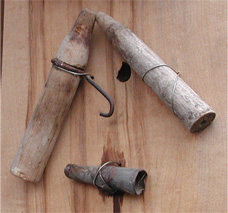 |
The first trees were tapped by simply gashing the tree and the sap collected in troughs placed on the ground. This proved to be hard on the tree.
Later it was discovered that a hole could be drilled and a wooden spile inserted for the sap to flow out. A wooden or metal bucket would collect the sap.
|
|
While the nature of tapping sugar maple trees has remained unchanged over the years, technology has seen minor changes to the spiles. On the left is a cast metal unit with built-in hook for holding a bucket. (Its use can be seen above.) Note also a stop which determines the depth for which the item is allowed to penetrate the tree bark. The newest spile is made of plastic and since it is connected to a hose, there is no facility for hanging a bucket.
Proper sized holes are made in the tree using a drill on a gas engine. Taps are removed from the tree at the end of sugaring and the hole closes naturally during the growing season.
Processors first have to get into the woods. When winter snows are deep, snowshoes are worn in the sugarbush to tap the trees. When it comes time to remove the taps after the snows are melted, it may be necessary to bring a ladder along to reach the taps.
|
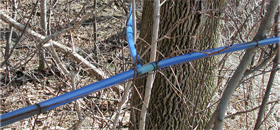
Food grade tubing is connected between spiles and storage tanks. Gravity keeps the sap flowing downhill into the storage tanks.
|
Wild animals such as squirrels and coyotes find the sweet sap attractive. They gnaw the tubing which makes replacement of sections necessary. Some processors bury their lines to keep the damage to a minimum.
|
|
|
Old stainless steel milk tanks are frequently recycled into use as sap storage tanks. Sap must be collected from the tank every day for processing as the unprocessed sap can be kept for only one day.
|
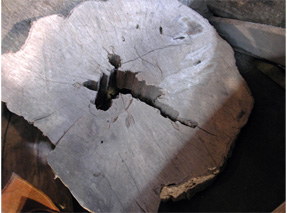 |
This 150+ year-old tree on exhibit at Randall's had over 300 tap marks. The early taps were done with a hammer and chisel.
|
|
|
Step 2 - From Sap to Shack
|
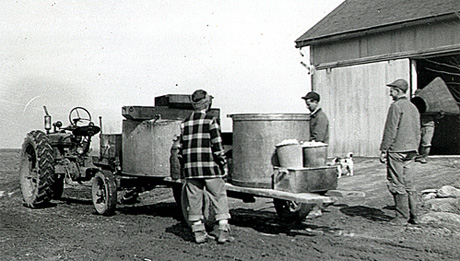
Elizabeth's aunt and two uncles prepare to collect sap around 1950 on the family farm in Marilla, NY
|
|
In early days, wooden yokes were used to help carry buckets of sap. One processor told of his ancestors using a yoke to carry two buckets and their hands to carry another two buckets though the woods. In the old photo above, a tractor replaces the team of horses used to transport the tank of sap to the sugar shanty.
During sap harvest time of year the weather can be very unpredictable. There could be several feet of snow on the ground or the spring thaws and rain could have turned the woods into a mudhole. Since it takes a lot of sap to make a small amount of maple syrup, farmers are always looking for creative ways to collect the sap with the least expenditure of energy.
Below is the tractor and wagon version used by the Siler family in Wyoming county, NY to transport their sap from the collection tank to their sugar shack. A ride in a heated cab down paved country roads is a far distance from Currier and Ives prints of collecting sap.
|
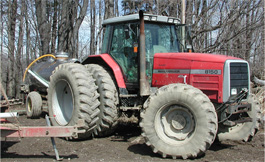 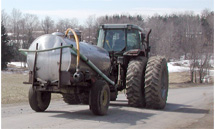
|
Step 3 - Boiling Down
|
|
The sap collected from a sugar maple tree is about 2% sugar and over 40 gallons of sap are needed to make one gallon of syrup which is 66% sugar.
We were told the picturesque iron kettle over a fire pictured above was only used for the final finishing off boiling the sap down in the old days. The initial boil would been done in large iron cauldrons that had a firebox built under them. When the sap had been almost reduced to it's final stage, it was transferred to the tripod supported cauldron for final boiling.
Today, some processors use a reverse osmosis filter to remove part of the water. This form of filtering was was brought online in the 1970s and by reducing the amount of water in the sap, the amount of time and fuel needed to reach the syrup stage was reduced.
|
|
The evaporator can be viewed at Siler's from a catwalk. The 2% tree sap is put into the covered section to the left and boiled until it is reduced to an 8% solution. It then is poured into the far side of the open pan and gradually flows through the different divisions, cooking down as it goes. Heat under the pan is generated by either firewood or gas. The resulting cloud of steam escapes out the upper cupola. When the sap reaches the last section of the pan it is tested for sugar level and a temperature of 7 degrees above boiling. It is then poured off into stainless steel drums. After a final filtering the sap is bottled and ready for sale.
Larger processors such as Merle's have a thermostat probe to sense when the proper temperature is reached in the final section of the pan. When the desired temperature is reached, the sap is automatically drained and packed into stainless steel drums.
|
|
At Perl's sugar shack, the old fashioned way of testing syrup was shown. When the proper temperature is reached, the sap will sheet off the scoop. The room full of steam shows why boiling sap inside the family kitchen is not recommended. Also you could feel the sweetness in the steam.
Even with reverse osmosis filtration, boiling down the sap can take hours.
Sap that is undercooked will ferment and if overcooked will develop crystals in the bottle.
Small evaporators sized 2'x 6' may process 25 gallons per hour. Big 6' x 18' evaporators can process 380 gallons per hour.
|
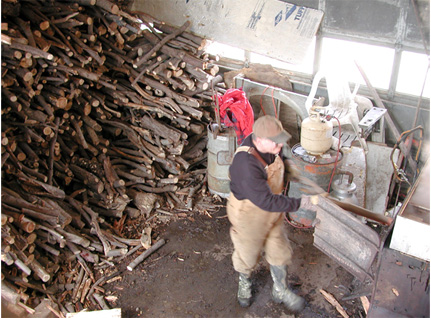
Boiling Down With Wood in Perl's Sugar Shack.
Seasoned firewood is gathered and stored where it will be nice and dry to fire the evaporator. Since Siler's were boiling sap since Christmas Day, they had used quite a bit of their summer and fall accumulated wood.
|
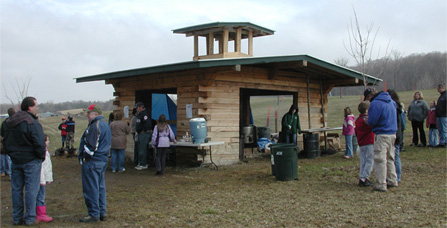
Merle Farms hot dog stand.
Some of the producers offered tasty food spotlighting the syrup and it's derivations. Perl's offered free pancakes with warm syrup. Merle Farms (pictured above) sold hot dogs and hard boiled eggs cooked in maple syrup. A large pot of chili was available for the less than adventuresome.
Samples could also be had of fresh maple syrup, maple cream and maple cotton candy.
|
Grading - There are two different grades of syrup: A and B. Grade A is broken down into light amber (early season) , medium amber and dark amber. Grade B (late season) is darker than dark amber and is used in cooking with it's full robust flavor.
Marketing - The price for real maple syrup was around $40 per gallon this year.
During the festival weekends, producers offer for sale other maple products besides syrup.
Maple syrup that is cooked down becomes maple spread. It can be flavored with cinnamon or raspberry.
Maple cream is spread that has cream added to it. It is spread on warm toast. It must be refrigerated.
Maple sugar is sap that has all the water boiled off. The granulated sugar can be used in recipes or sprinkled over food.
|
| Links:
These are the nice folks we visited:
Randall's Maple Products http://www.randallsmaple.com/
Merle Maple Farm http://www.merlemaple.com/
Perl's Maple Products http://www.perlsmapleproducts.com/
Siler's Sugar Shanty http://www.silersugarshanty.com/
For more information on the New York Maple Weekend check out
http://www.nysmaple.com/maple_weekend.html
|

